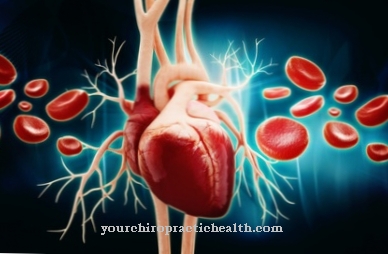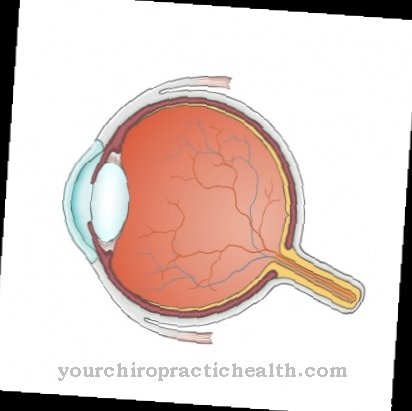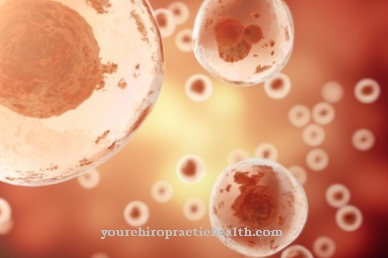The Vasculogenesis is a process of embryonic development in which the vascular system is created from endothelial progenitor cells. Vasculogenesis is followed by angiogenesis, which causes the first blood vessels to sprout. In the broadest sense, cancer can be viewed as a vasculogenetic problem.
What is vasculogenesis?

In medicine, vasculogenesis refers to the formation of blood vessels, which endothelial progenitor cells serve as the starting material. These cells come from the bone marrow and are attracted by messenger substances. These cytokines include, for example, the vascular endothelial growth factor (VEGF).
After the messenger substances are released, the precursor cells migrate from the bone marrow to the place of the messenger substance via the bloodstream. On the one hand, this process plays a role in wound healing and the associated formation of new vessels and, on the other hand, can be traced back to pathological relationships such as tumors.
In the meantime, medicine also assumes that vasculogenesis also plays an increased role during embryonic development and that angiogenesis occurs almost exclusively in adults. The formation of new vessels through sprouting and splitting processes, which uses pre-formed blood vessels as the starting material, is considered to be such. A third type of vascularization is arteriogenesis, in which arteries and arterioles are formed through the recruitment of smooth muscle cells.
Function & task
The term vasculogenesis includes any type of new vessel formation from precursor cells from the vascular endothelium or angioblasts. The term often refers in particular to the regeneration processes of vessels in embryonic development. These processes begin with the differentiation of mesodermal cells and continue with the aggregation of these cells, which takes place in the area of the yolk sac and contains common progenitor cells from the vascular system and the blood-forming system.
These progenitor cells are also known as hemangioblasts. The resulting cell conglomerates are called blood islands. Their differentiation takes place under the influence of growth factors. The influence of VEGF in particular plays a role here. Differentiation turns the progenitor cells into marginal angioblasts and central hematopoietic stem cells. The angioblasts become endothelial cells and as such form the first human vessels.
These processes are followed by processes of aniogenesis. The first blood vessels sprout during these processes and form the entire blood system through the sprouting. Since the primitive cells of the endothelium coalesce and in this way form intercellular contacts, the individual vascular compartments, known as the intravascular space, arise from the process after additional differentiation and growth processes.
The first vessels form in the embryonic development as early as the 18th day. These primary vessels correspond to the so-called umbilical vessels and, in addition to the umbilical artery, include the umbilical vein from which all other vessels arise.
After completion of the embryonic development, vasculogenesis hardly occurs in its actual form. In adults, neovascularization usually takes place either in a compensatory manner or corresponds to destructive processes. In contrast to embryonic development, new vessels in the adult organism ultimately only arise on the basis of existing vessels in the form of angiogenesis.This new formation is mainly limited to the processes of wound healing.
Like the pathological and uncontrolled neovascularization in the context of tumor diseases, the physiological neovascularization after injuries or in transplant medicine is sometimes included under the term neovascularization. Although this term is related to vasculogenesis, it should not be understood as a synonym.
Illnesses & ailments
The Vascular Endothelial Growth Factor (VEGF) plays a major role in connection with vasculogenesis. This growth factor has the highest clinical relevance when it comes to processes of vesculogenesis. The substance is a signaling molecule that drives vasculogenesis and the subsequent angiogenesis. The growth factor stimulates the endothelium and has effects on monocytes and macrophages that migrate through the substance.
In vitro, VEGF has a stimulating effect on the division and immigration of endothelial cells. In clinical practice, increased expression of VEGF-A is associated with some tumors. The monoclonal antibody bevacizumab can bind to VEGF and in this way inhibit pathological neovascularization. Bevacizumab therefore plays a role in the treatment of various types of cancer. Phase III studies have successfully used the substance to fight colon cancer, lung cancer and breast cancer. Phase II studies also exist for the treatment of cancers such as pancreatic cancer, prostate cancer and kidney cancer.
Ranibizumab is known as a fragment of the same antibody. This substance is used therapeutically when macular degeneration is associated with new blood vessels. In addition, tyrosine kinase inhibitors such as sunitinib or vatalanib, which have an inhibitory effect on VEGF receptors, are now also used against diseases such as cancer.
There is a simple reason that cancer is related to vasculogenesis. From a certain size, a tumor needs its own vascular system. Only in this way will it be adequately supplied with nutrients and oxygen and be able to grow in size. Therefore, when the supply of oxygen and nutrients is blocked by an interruption in the vasculogenic processes, the growth of the tumor stops.
Activation of vasculogenesis can also be relevant for medicine. This is especially true after transplants. Only the connection of transplants to the vascular system ensures their oxygen and nutrient supply and enables a transplant to succeed.

















.jpg)






.jpg)


